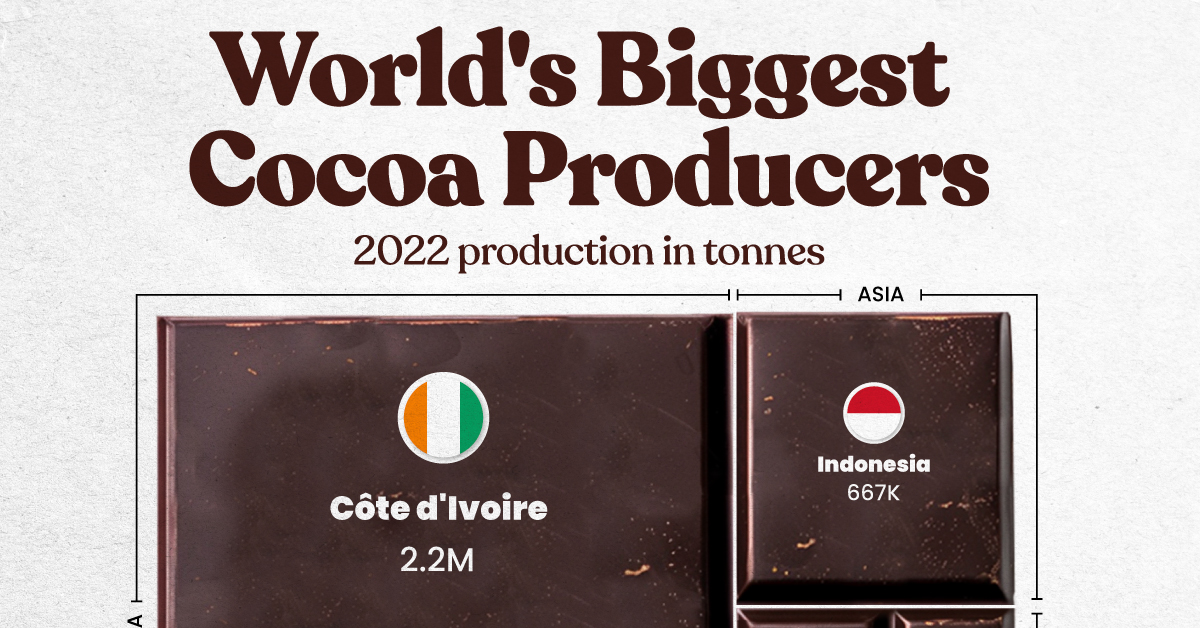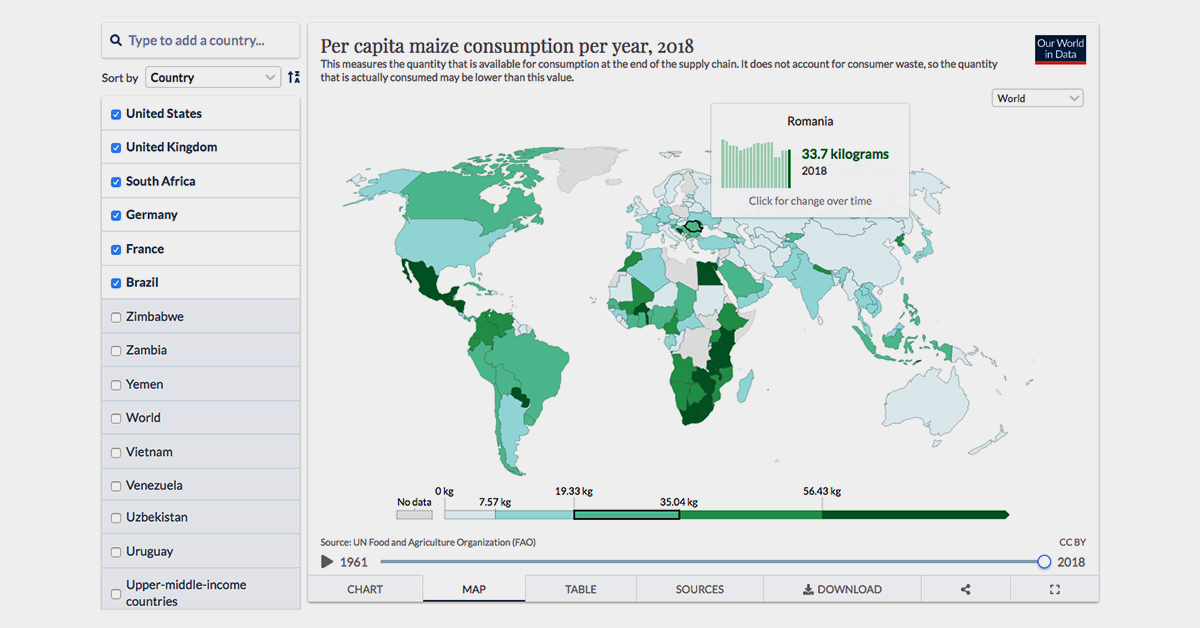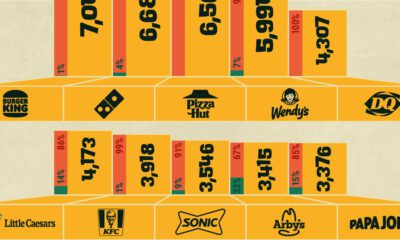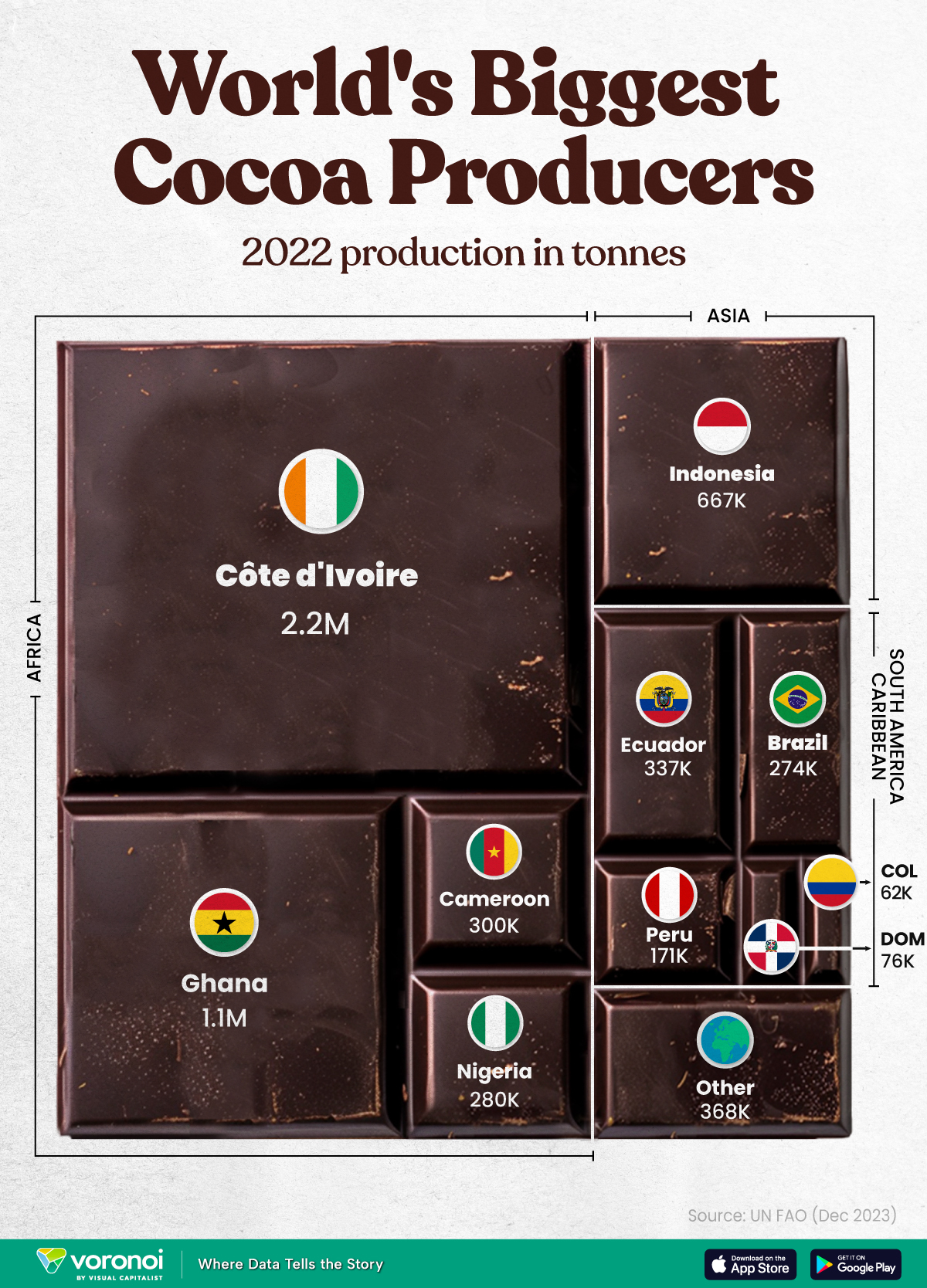Agriculture
Mapped: Food Production Around the World
Mapping the World’s Food Production
In a world of nearly 8 billion people, food security is one of the greatest challenges we face.
Roughly 700 million people suffer from hunger every day, lacking access to staple foods like maize, rice, and wheat. While many people often take the availability of food for granted, it’s worth taking a moment to identify and acknowledge where the food we consume comes from.
From staple crops to exotic fruit, this interactive map from Our World in Data shows global food production using data from the United Nations Food and Agriculture Organization (FAO).
A Closer Look at Staple Food Production
Which countries produce the foods that we eat every day? Here’s a look at the top producers of three of the world’s most important staple foods.
Maize (Corn)
Corn or maize is the most widely-grown crop in the Americas, with uses in various industries. While the crop is native to Central America, it is grown in all parts of the world.
| Country | 2019 Production (million tonnes) | % of Global Production |
|---|---|---|
| U.S. 🇺🇸 | 347.0 | 30.2% |
| China 🇨🇳 | 260.8 | 22.7% |
| Brazil 🇧🇷 | 101.1 | 8.8% |
| Argentina 🇦🇷 | 56.9 | 4.9% |
| Ukraine 🇺🇦 | 35.9 | 3.1% |
The U.S. is by far the largest corn producer and exporter, with large amounts of corn coming from the states of Iowa, Illinois, and Nebraska. Over 90 million acres of land is used to grow corn, an area nearly the size of Montana.
The U.S. is also the largest consumer of corn, followed by China, the second-largest producer and consumer.
Wheat
First domesticated in the Middle East, wheat is a versatile crop that grows well in temperate climates. Wheat is usually milled into flour, which is then used to make bread, pasta noodles, biscuits, and other common foods.
| Country | 2019 Production (million tonnes) | % of Global Production |
|---|---|---|
| China 🇨🇳 | 133.6 | 17.4% |
| India 🇮🇳 | 103.6 | 13.5% |
| Russia 🇷🇺 | 74.5 | 9.7% |
| U.S. 🇺🇸 | 52.3 | 6.8% |
| France 🇫🇷 | 40.6 | 5.3% |
China and India combined for nearly 31% of global wheat production in 2019, with Russia, the U.S., and France producing smaller but significant amounts of the crop.
Rice
Chinese hunter-gatherers first cultivated rice 9,400 years ago along the banks of the Yangtze River. It’s now the third most-produced crop in the world and a staple food for over 3.5 billion people, primarily in Asia.
| Country | 2019 Production (million tonnes) | % of Global Production |
|---|---|---|
| China 🇨🇳 | 209.6 | 27.7% |
| India 🇮🇳 | 177.7 | 23.5% |
| Indonesia 🇮🇩 | 54.6 | 7.2% |
| Bangladesh 🇧🇩 | 54.6 | 7.2% |
| Vietnam 🇻🇳 | 43.5 | 5.8% |
It’s no surprise that the countries with the biggest populations are the top producers of rice. Furthermore, 9 of the top 10 rice producers are in Asia, which is a testament to how important it is for people living in the region.
While maize, wheat, and rice are important staple foods, our diets are shaped by various factors, including geography and culture. Explore the origins of the foods you like using the above interactive visualization.
How to Use the Interactive
For an overview of food production for a particular crop, select the crop using the “Food” drop-down menu, and the map will update automatically. Countries with darker shades of green produce more of the crop, and vice versa. You can hover over countries to see more in-depth production statistics.

To zoom into a specific continent, use the drop-down menu on the right where “World” is selected, and select a region of your choice.
For a historical overview of food production, click the play icon on the bottom left corner of the map, and you’ll see how the biggest producers of a crop changed over time.

By clicking the “Chart” button on the bottom left, and selecting the country (or countries) of your choice, you can see production trends over time. You can also look at the data in a tabular format by clicking on the “Table” button.

This article was published as a part of Visual Capitalist's Creator Program, which features data-driven visuals from some of our favorite Creators around the world.
Markets
The World’s Top Cocoa Producing Countries
Here are the largest cocoa producing countries globally—from Côte d’Ivoire to Brazil—as cocoa prices hit record highs.

The World’s Top Cocoa Producing Countries
This was originally posted on our Voronoi app. Download the app for free on iOS or Android and discover incredible data-driven charts from a variety of trusted sources.
West Africa is home to the largest cocoa producing countries worldwide, with 3.9 million tonnes of production in 2022.
In fact, there are about one million farmers in Côte d’Ivoire supplying cocoa to key customers such as Nestlé, Mars, and Hershey. But the massive influence of this industry has led to significant forest loss to plant cocoa trees.
This graphic shows the leading producers of cocoa, based on data from the UN FAO.
Global Hotspots for Cocoa Production
Below, we break down the top cocoa producing countries as of 2022:
| Country | 2022 Production, Tonnes |
|---|---|
| 🇨🇮 Côte d'Ivoire | 2.2M |
| 🇬🇭 Ghana | 1.1M |
| 🇮🇩 Indonesia | 667K |
| 🇪🇨 Ecuador | 337K |
| 🇨🇲 Cameroon | 300K |
| 🇳🇬 Nigeria | 280K |
| 🇧🇷 Brazil | 274K |
| 🇵🇪 Peru | 171K |
| 🇩🇴 Dominican Republic | 76K |
| 🌍 Other | 386K |
With 2.2 million tonnes of cocoa in 2022, Côte d’Ivoire is the world’s largest producer, accounting for a third of the global total.
For many reasons, the cocoa trade in Côte d’Ivoire and Western Africa has been controversial. Often, farmers make about 5% of the retail price of a chocolate bar, and earn $1.20 each day. Adding to this, roughly a third of cocoa farms operate on forests that are meant to be protected.
As the third largest producer, Indonesia produced 667,000 tonnes of cocoa with the U.S., Malaysia, and Singapore as major importers. Overall, small-scale farmers produce 95% of cocoa in the country, but face several challenges such as low pay and unwanted impacts from climate change. Alongside aging trees in the country, these setbacks have led productivity to decline.
In South America, major producers include Ecuador and Brazil. In the early 1900s, Ecuador was the world’s largest cocoa producing country, however shifts in the global marketplace and crop disease led its position to fall. Today, the country is most known for its high-grade single-origin chocolate, with farms seen across the Amazon rainforest.
Altogether, global cocoa production reached 6.5 million tonnes, supported by strong demand. On average, the market has grown 3% annually over the last several decades.
-

 Green1 week ago
Green1 week agoRanked: The Countries With the Most Air Pollution in 2023
-

 Automotive2 weeks ago
Automotive2 weeks agoAlmost Every EV Stock is Down After Q1 2024
-

 AI2 weeks ago
AI2 weeks agoThe Stock Performance of U.S. Chipmakers So Far in 2024
-

 Markets2 weeks ago
Markets2 weeks agoCharted: Big Four Market Share by S&P 500 Audits
-

 Real Estate2 weeks ago
Real Estate2 weeks agoRanked: The Most Valuable Housing Markets in America
-

 Money2 weeks ago
Money2 weeks agoWhich States Have the Highest Minimum Wage in America?
-

 AI2 weeks ago
AI2 weeks agoRanked: Semiconductor Companies by Industry Revenue Share
-

 Travel2 weeks ago
Travel2 weeks agoRanked: The World’s Top Flight Routes, by Revenue















